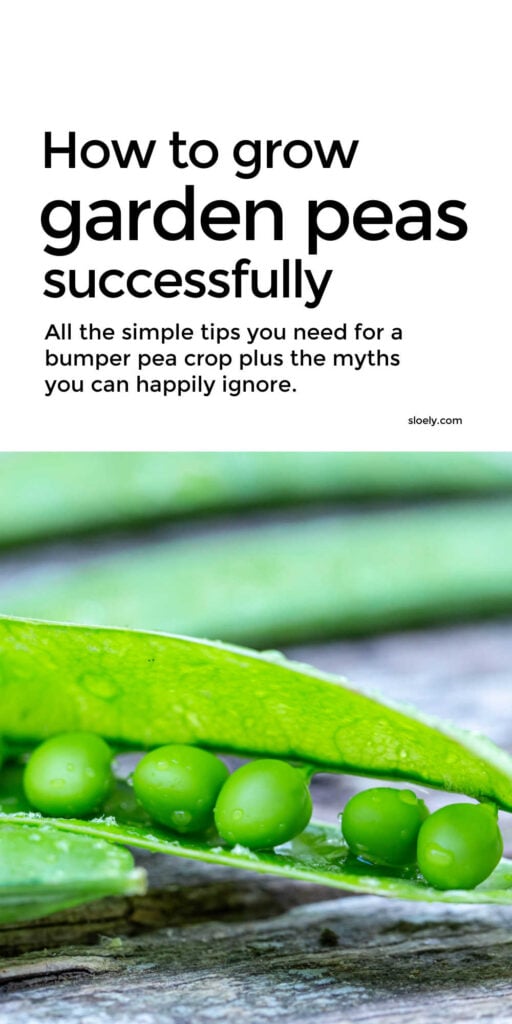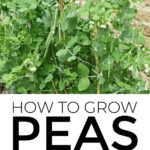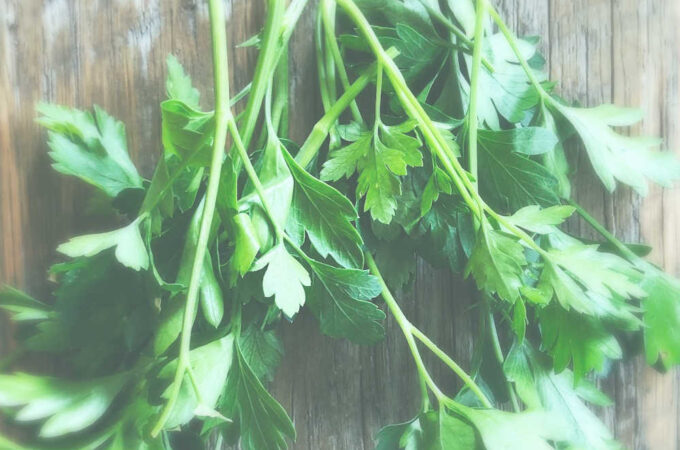
Growing peas in the garden is a joy but it is incredibly easy to over complicate pea growing – especially if you’re trying to garden organically – and to end up with a tiny, sickly crop.
Fear not.
Growing peas successfully really can be simple – even organically – as long as we focus on essentials and ignore lots of confusing myths.
So I have for you here essential tips on how to grow peas successfully and – if you want to – organically. You’ll find everything you need to know about how to grow peas including answers to all your big questions
There’s a lot of information but it’s all organised in clear sections with simple bullet lists with my key pea growing tip at the top of each section. So do bookmark or save the post for quick reference.
I hope these simple tips help you grow a bumper pea harvest without any faff. For more simple vegetable gardening tips for beginners do check out my other grow your own posts.
Table of Contents
What Is The Best Month To Plant Peas
- Top tip : plant peas early as they don’t like hot sun but keep warm with a DIY cloche before the last frosts.
- The best month to plant peas is March or a month before the last frost in your area.
- But you can plant peas in February under DIY cloches or in pots in a mini greenhouse. It’s often too warm to germinate peas inside.
- Early seeds can rot in cold soil but smooth seeds seem more cold resistant than wrinkled seeds.
- You can keep planting peas until June but only if weather is mild. Peas germinate best under 75f / 24 f. In recent hot Mays in London my later planted peas refused to germinate.
- For a fall crop plant peas at the end of summer, 6 weeks before first frost.
- You can plant peas in November to grow over winter but choose smooth seeds & dwarf plants which are easier to protect from frost.
Do You Need To Soak Peas Before Planting?
- Top tip : pea seeds do not need soaking.
- Lots of gardeners tell us to soak pea seeds overnight before planting to speed up germination but I confess I never have.
- Soaked peas do germinate quicker than un-soaked peas.
- But it has been shown soaking peas before planting doesn’t produce bigger or healthier plants.
- Keeping things simple is key to vegetable growing success for beginners so if we don’t need to soak peas then don’t bother.
How To Plant Pea Seeds Indoors
- Top tip : plant pea seeds indoors in February to get ahead.
- You can start seeds in a greenhouse or cool home in February as long as temperature is not greater than 70 f / 21 c
- Plant in small pots or toilet rolls with a good two inches of soil depth.
- Plant pea seeds about one inch deep.
- Don’t grow them in an undivided tray – I tried – as even well spaced roots get tangled and damaged when transplanted.
How To Plant Pea Seeds Outdoors
- Top tip : plant peas in warmed moist but not soggy soil.
- Pea seeds can rot in cold soil so warm soil with DIY soda bottle cloches for a week or so in advance if planting outside.
- And then grow the peas under the cloches until weather warms up.
- Plant pea seeds 1 to 2 inches deep.
- Plant seeds 2 to 3 inches apart and don’t be tempted to plant closer as tightly packed peas more vulnerable to mildew.
- Pick a spot with plenty of morning sun that won’t get scorched in a hot May or June.
- Keep soil moist but not soggy to prevent seed rot.
- Peas can take anything from 7 to 30 days to germinate depending on the weather. If planted outside they will take longer.
When To Plant Out Peas
- Top tip : don’t let pea seedlings out grow their pots.
- Plant out pea seedlings within 4 weeks or at first sign of roots emerging from bottom of the pot as otherwise they become weak and leggy.
- If you can’t get them out in the garden transplant to bigger pots.
How To Grow Peas In Pots & Containers
- Top tip : you can grow peas successfully in pots but other vegetables miss out on their soil improving benefits.
- Peas can easily be grown in pots and containers in a small patio garden.
- But peas do have quite long roots so it makes sense to grow dwarf peas such as Kelvedon Wonder in pots and containers.
- Even dwarf peas need a foot or so depth of soil in the pot.
- Pea containers also need space for the support even dwarf peas need to grow successfully vertically. See section 6.
- The downside of growing peas in pots is other vegetables miss out on the beneficial nitrogen peas help “fix” in the soil.
- Plant peas in pots 1 to 2 inches deep and an inch or so apart.
- Dwarf peas are adapted to grow closer together with less risk of mildew but place pots somewhere with plenty of air to keep ventilated.
How To Support Peas Vertically
- Top tip : successful peas need support early on; don’t skip it!
- Peas can grow vertically very successfully all by themselves but they need something to grow up. Our key job is to provide it.
- Dwarf peas only grow to about 50cm but still prefer support.
- Peas use tendrils to support themselves.
- First tendrils appear when pea plants are barely an inch or so tall.

- As soon as tendrils appear peas need something to grow up – a tiny chop-stick or pencil thin stick popped in a pot with them is fine.
- You can easily support peas in various ways.
- Pea sticks : traditionally peas are grown up two rows of interwoven pea sticks which are 5 or 6 foot slim sticks complete with twigs pruned from trees such as hazel. The twigs give the tendrils something to grab.
- Pea tee-pee : alternatively you can make a pea tripod. These are good in bigger vegetable gardens with plenty of space around the bed to keep the peas well ventilated to prevent mildew.
- Pea trellis : you don’t need to buy trellis you can simply make a rustic trellis out of sticks although I do recommend using square lashing.
- Net trellis : You can also run netting between two poles to make a trellis. Single row trellises are useful when growing vegetables in a small space.
- Peas in pots & containers can just be supported with vertical pea sticks.
How Often To Water Peas
- Top tip : Don’t over water young but water well in flower.
- Keep soil around seeds and seedlings moist but not soggy.
- In spring they may not need watering.
- Water more heavily when peas in flower.
- Water soil avoiding leaves to prevent mildew.
What To Feed Peas With
- Top tip : peas grown on good soil don’t need feeding.
- Many gardeners tell us to feed peas weekly once flowering with a potassium rich potash feed but it’s better to add good compost or manure to the soil before planting. And that’s not just good practice organically it also saves money.
- Yellowing leave edges do indicate potassium deficiency.
- Constantly feeding fruiting vegetables can be expensive if you are trying to grow vegetables on a budget. Banana skins, coffee grains and wood ash are all cheap ways to add potassium to the soil.
- There are tips here on how to make homemade potassium for plants.
- Grow comfrey to use as a DIY organic potassium liquid feed.
Best Vegetables To Grow With Peas
- Top tip : peas are great companion plants for many vegetables as they fix nitrogen into the soil.
- Avoid planting peas in beds with the allium family e.g. chives, garlic, onions & leeks as they may inhibit germination.
- Leafy greens such as spinach and turnip greens like nitrogen rich soil and can benefit from being grown with peas. This is a key tip if you want to start gardening organically because it will help you to avoid adding nitrogen feeds to your soil.
- Parsley grown underneath peas can help attract predators who control the pea moth caterpillars.
What Is Eating My Peas
Peas do suffer from a few common pests but these can all be controlled pretty easily organically in a small vegetable garden :
- Slugs & snails : love to eat young pea plants so use these tips to get rid of slugs and snails naturally.
- Pea moths : lay eggs on pea flowers and caterpillars then emerge in the pea pod and eat the peas.
- Leaf miners : white trails through pea leaves are a sign of leaf miners, the larvae of small flies. Look out for thin white eggs under leaves and pinch out trails as soon as they appear. Good companion plants like spinach are also vulnerable so consider growing under mesh covers that prevent flies laying eggs.
- Pea & bean weavil : distinctive u-shaped notches around edges of leaves are a sure sign of the pea and bean weavil. Protect young plants with cloches.
- Pea aphid : tiny green and pinky red insects pea aphids can spread mosaic viruses that give leaves a distinctive mottled mosaic appearance. Crush pea aphids off as soon as they appear. Or gently wash off with mild diluted dish soap. Ladybirds will feed on them. Mesh netting can help to prevent them getting onto the plants.
What’s Wrong With My Peas : Common Pea Diseases
Common pea diseases that can undermine pea crops can be prevented pretty easily and organically with simple healthy planting rules :
- Mildew : peas can suffer from downy mildew and powdery mildew
- Downey mildew : under side of leaves covered in mainly white but sometime black or purple mildew with brown or yellow spots. It is the result of poor ventilation and damp plants and best prevented by planting peas well spaced in warm, well ventilated beds.
- Powdery mildew : leaves and pods can be covered in all white mildew. It is caused by plants getting too hot and dry. Best prevention is to plant early so you can finish harvest before hot weather. Or to plant later in well ventilated, warm beds that don’t get full midday & afternoon sun.
- Foot, root & stem rots : rotting roots and seeds can be caused by fungus which is best prevented by rotating crops.
- Pea cyst nematodes : weak, unhealthy plants with white cysts on their roots caused by tiny nematodes. Again they are best prevented by crop rotation.
How To Grow Peas Organically
All the tips in this post have really been about growing peas organically but to recap this is how to grow peas successfully organically :
- Dig compost or manure into soil in early march a few weeks before planting.
- Don’t assume you need to feed peas if soil was well composted.
- Only feed if you didn’t compost well or any sign of leaf yellowing.
- Start growing comfrey for potassium rich organic feed.
- Save up banana skins & coffee grains to make organic potassium feed.
- Give peas plenty of space to avoid fungal disease.
- Grow peas with leafy greens such as spinach, turnip greens and cabbages that benefit from nitrogen rich soil so you can stop adding nitrogen feeds to your vegetable garden.
- Cover beds in mesh netting to prevent leaf miners, pea moths and pea aphids organically without spraying pesticides.
- Rotate peas between beds as much as possible from year to year to feed soil and naturally prevent build up of fungal disease in beds.
And there you go. Everything you need to know about how to grow peas successfully and organically. Do bookmark or save the tips for reference.
- How To Grow Spinach Tips
- Growing Turnip Greens & Cime Di Rapa
- Growing Vegetables From Scraps
- Quick Growing Vegetables
- Organic Gardening Tips For Beginners
- Organic Weed Control
- Growing Vegetables For Beginners On A Budget
- How To Grow Raspberries In A Small Space

Original images: Close up of green fresh peas and pea pods by Marco Verch, all other images by sloely.com under Creative Commons 2.0















Leave a Reply